Feature Interview with Randy Thompson
September 2007
Randy Thompson is president of American Golf Course Design, LTDA based out of Santiago, Chile. During the past eleven years this company has evolved into South America’s leading design firm with prestigious designs found throughout the southern cone of South America and more recently in Central America. Randy grew up in Western Massachusetts and holds an associates degree in turf grass management from Stockbridge School of Agricultural and a bachelor degree in plant and soil science from the University of Massachusetts both located in Amherst, Massachusetts. He worked early in his career in north Texas as a certified golf course superintendent before focusing his efforts into golf course construction and design.
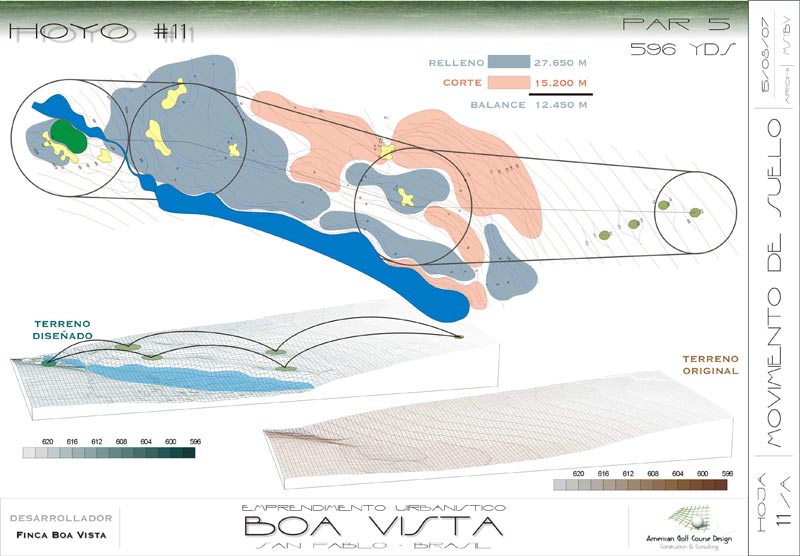
Thompson uses modern technology to create detailed plans to 1) keep the entire team focused on what should be the final product and 2) educate the client. In this manner, Thompson carries out the bulk earth moving in an economical and efficient manner.
How did you get your start in golf course design?
I climbed the ladder so to speak, I grew up next to a military base golf course in Western Massachusetts and started working on a golf course when I was 17 years old cutting greens and general maintenance. I went to the two year turf program at Stockbridge and then transferred to UMASS and obtained a Bachelor of Science degree in plant and soil science. Worked as a superintendent and then went into construction and grow in for Robert Von Hagge and in 1996, I started American Golf Course Design, Construction & Consulting.
What did you learn working with Robert von Hagge?
A lot, but basically the fundamentals of good design practices and he really likes to work with shadows to bring more art into his designs.
How did you gravitate toward working in South America?
The Stockbridge turf grass management program at the University of Massachusetts was graduating about sixty students a year in the mid seventies and about five per year went on to the four year program. So every year, sixty more candidates were put into the job market in New England and the surrounding areas. There was very little new construction at that time in that demographic area maybe one new course per year was opening up. The Southwest on the other hand was booming with new course openings and the only turf grass oriented school was Texas A&M. They were graduating 3 to 5 students at the time and with fifty to sixty new course opening in the southwest. So, I concentrated my job search in this area and got my first superintendents job right out of school at a public course for the city of Fort Worth, Texas. By the time I was 24 I was Superintendent of a golf course with a PGA tour event in Texas. That was great and fun for three years but I started to get itchy and wanted to continue to grow, so I accepted a position as construction supervisor and grow in superintendent for a project that Von Hagge and Bruce Devlin owned, the Cliff’s at Possum Kingdom Lake. Shortly after opening the bank took over the project during the Savings and Loan crisis of the mid to late eighties and I stayed on as Director of Golf. I also got my real estate license and sold real estate at the project. The bank went bankrupt and the FSLIC or something like that took over the project and they didn’t have any money either, so things were a little insecure. I stayed in touch with Bob who was doing a lot of projects in Europe. We came to terms and I was going to open up an office for him in Europe and oversee several courses but would be based out of France. By the time I got my work permit, a recession hit Europe pretty hard and he lost a few signed contracts and we decided to wait. He then offered me to go to Argentina for a client and construct thirty six holes which I accepted and is now the twenty seven hole golf course, Buenos Aires Golf Course, which hosted the 2000 world cup and is rated one of the top 100 courses out of the USA.
Which do you consider yourself first, a golf course architect or a businessman?
That’s a good question, at the present time I guess something like 50% golf course architect and 50% businessman. We are doing a lot of landplaning for golf residential communities and we get involved in the entire development process. I think it’s important that the golf architect should understand and take into consideration the entire business plan when designing the golf course and the same holds true with landplaning. The days are coming to an end where you will be able to get by with an attitude of, I was hired to bring out the best possible golf course from this piece of land, its somebody else problem how they are going to pay for it! The business plan should come first and there has to be harmony in all areas to coincide with the design.
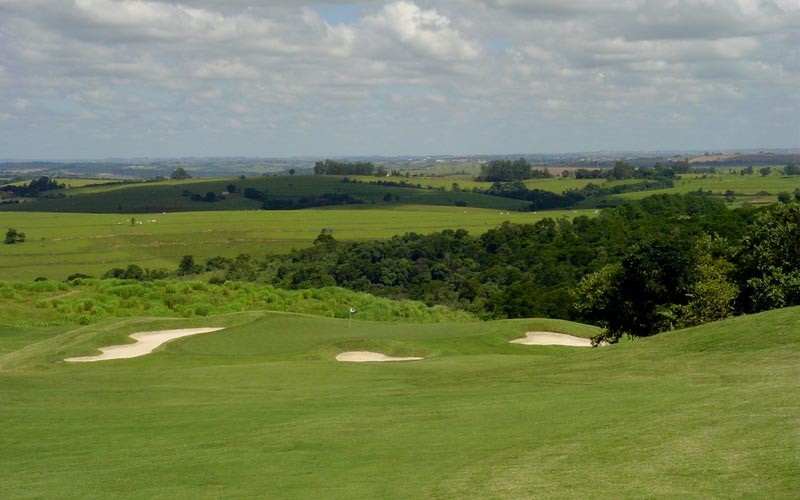
Rolling terrain is typical outside of Sao Paulo, Brazil. The property used for the first nine holes at Boa Vista required a routing on an existing slope with over one hundred and fifty feet difference in elevation. This area receives several heavy torrential rains per year and as a result the design project became a major engineering task.
What are the biggest obstacles that you typically face in designing courses in South America?
Lack of experience in all areas and having to work in so many different countries because there is not sufficient new course development in any one country to pay the bills. This means forming new teams in each specific Country or asking your key people to stay volatile. Successful golf oriented real estate projects require strong experienced teams and most developers down here lack that experience. So you have to form the teams and educate the owners and it’s not always easy. You can be the best architect in the world and have one of the top properties in the world but if you don’t have an owner that ‘gets it’ or the right construction team and a good superintendent you will end up with just another dime a dozen golf course.
Tell us about some hidden gems that you have discovered in South America.
One I can’t talk about yet but it may be one the best pieces of land left on the earth for a links type golf course, its so good I am recommending to the owner to hire an architect that has top one hundred experience. We are going through the permitting process but you will hear about it sometime in the near future. The best hidden gem built to date in this area is La Serena Golf Club, which is located about 300 miles north of Santiago, Chile. It’s a dunes course that we finished around the year 2,000. It is spectacular and visiting international guests that have played it absolutely love it and can’t say enough good things about it. I believe the cost is around twenty to twenty five dollars and if it was in North America it would be demanding 150 dollar green fees. Plus if you play outside of January and February you might have the entire course to yourself.
Every architect talks about strategy thoughmany struggle todeliver. Please describe what a strategic hole means to you.
I think we just saw a good example of a good strategic hole in this years US open, the par four seventeenth hole playing only 313 yards and Angel the eventual winner bogeyed the hole and Tiger made another good par saving putt. The only thing I would change on the hole is make the bunker a little more severe that Tiger hit into and I would do this by making it just a little deeper. The 12th hole was a par three playing 300 yards and this was playing just a little longer, Tiger had to choke down to a three wood in order not to fly it with his driver. I think a good holes provides alternatives and makes you think and rethink and if you make the wrong decision you should be reminded that you made an improper choice and your chances of par should be reduced severely but not eliminated.
Describe a favorite hole that you designed and what you like about it.
Number sixteen in Panama, Mantaraya Golf Club at the Decameron Resort. A slight dogleg right of four hundred and forty yards, playing up hill and usually into the wind. The tee shot only has a slight elevation up hill but the landing area is only about seventy yards long and fifty yards wide between two natural creeks. To carry the first creek you have to hit at least one hundred and ninety from the back tees and the second creek is situated about 260 and is about fifteen yards wide. One lone cross bunker sits on the left outside of the landing areas at about 245 yards from the back to help turn this ever so slight dogleg. Oh I forgot, the landing areas is also a little crowned and not real receiving and some say I went to far. My answer to that is, ‘Most good holes are controversial’. Wind is always a factor and most of the time coming at you so few try to drive the second creek and even fewer do it successfully. So if you’re smart you hit a well placed three wood but that leaves you with around 200 yards to the green uphill. The green setting is spectacular with natural vegetation and trees in the background for perception. We added some gentle mounding behind the green to enhance the framing process. There are no greenside sand bunkers but large grass hollows or fairway extensions because the green was elevated about five feet. Both sides of these fairway extensions are mowed at fairway height to give the player more options of just hitting a sand wedge out of long rough. The green has good movement from back to front in order to receive a well struck low iron or fairway wood but also at the same time making for interesting putting. It’s a tester and a bogey hole for most players. Take the bogey; accept it because if you get mad about the bogey or mad at me then chances are seventeen and eighteen will get you also, so shake it off, life goes on!

Santa Martina Golf and Nature Club nestled in the foot of the Andes four thousand feet above sea level and ten minutes from the capitol city of Santiago.
Please describe the attributes of the driving range at Santa Martina, Chile.
The golf course is tight but we left ample room for a quality driving range. It has around 300 yards in length and about one hundred and thirty yards wide.
The left side is a steep sloop coming off a cliff of one hundred and fifty feet. We have four target greens in the range with bunkering similar to normal golf holes for added perception. We also designed and constructed three smaller greens jutting out of the slope from the cliffs to produce even more realistic alternative targets with grass hollows because of the velocity of water run off coming off the hills. The hitting areas are two leveled and wide to handle the traffic and a putting green is established behind the practice area. To the far left of the hitting area is a practice sand bunker and a small green to either practice greenside bunker shots from the left or long cross bunker shots from the right of the bunker. All this in a setting with the Andes in the background with snow cover ten months out of the year.
Describe how the island hole came to be at Santa Martina.
I am not a big fan of water and even less of island greens because you take away the recovery shot but like I stated earlier we were very limited on land and even more limited on dirt, that is to say we were about 100,000 cubic meters short. Where we routed 9, 18 and eight were situated in a natural depressed area, where a lot of dirt had accumulated during the last million or so years. The rest of the property had about a two to four inch cap nothing more, so we created an island hole for hole number nine surrounded by seven or eight acres of lake and we were able to excavate the dirt that we needed for capping and shaping the rest of the course. This newly formed lake also acts as the principal lake for the demands of the irrigation system.
What are the best and worst pieces of property with which you have had to work?
La Serena definitely the best, sand dunes six to fifteen feet, set in an arid climate with a lot of desert vegetation and the majority of the course runs parallel to the sea. The area receives about four inches of rain a year and that comes in a two to three month period. We had control of the construction so we maintained and preserved what was there.
The worst would be Four Seasons Carmelo in Uruguay. Sixteen holes were created out of marsh or swamp but yet it is probably our best over all work to date. Just goes to show you that weak properties can be over come with a good knowledgeable owner, a good shaper, a good construction team and a good superintendent. Oh, and two halfway decent architects!

Randy Thompson exploring exciting dunesland property in Argentina.
What are the starkest differences between golf in North and South America?
I am glad you said starkest because otherwise this would have been a long answer. The starkest is the difference in the overall number of players. Golf in Latin America is still a rich mans game. I think the rule of the thumb in the US for example is that if you contemplating a new golf course, draw a circle with a five miles radius and if there are no other golf courses in that circle and a minimum population of fifteen thousand residents, then you should have the necessary support and volume for your project. Now to give an idea how things work in Latin America. The second largest city in Chile is Concepcion with a population a little over one million and they have had a nine hole golf course for sixty years or so. We added an additional nine holes around seven or eight years ago, making it the first eighteen holes course in the South of Chile. I believe they have around two hundred members today. What this tells you is, you need large populations to support golf in Latin America. Large populations are found in the major cities and land is so valuable and thereby expensive near the cities for golf development. Every major city in South America has courses but they were built fifty to eighty years ago when land cost were still reasonable. New development is occurring where the cities are expanding to suburbs with residential development around the golf courses. Many families are choosing a longer commute to work in exchange for suburb living with increased green space and security.
There is also an increasing market demand for second home “ weekend retreats and most of these have greater success if they are developed in a closed gated community and associated with a golf course and additional recreational amenities. I don’t have the exact numbers but I feel comfortable stating that around 85 percent or higher, of the total rounds of golf played in South America are played during the weekend.
Tell us about Santa Cruz Country Club and the construction process of the additional nine holes.
Santa Cruz dol Sur is in the south of Brazil about 150 kilometers from Porte Allegre. It has a population of about 70,000 and is the capitol of tobacco production for South America. They have had nine holes of golf for about sixty years and sixty members when they contacted me in 1995. They were considering adding an additional nine holes. Although there were few members, all the major tobacco companies are based there and there is a lot of International business men from the US, South Africa and Europe coming and going and the golf course has played an important role in conducting business throughout the years. Dues were about twenty dollars a month which gave an over all budget of about $1200 per month for the maintenance department. They did however have two big tournaments per year during harvest time which allocated about 30,000 dollars per year. One of the tobacco companies pushed the project and paid my fee’s of fifteen thousand dollars for the design of the additional nine and some much need changes to the original nine holes. This was my first project. They also explained this would be a slow gradual project with the objective of finishing in five years. The members that got involved and pushed and pulled when needed. This project consisted of some of the finest people I have met anywhere in the world. One of the members had a construction company and provided machinery and labor just about at cost. Others donated so much time plus their hearts and soul’s. They had no clue but put so much heart and soul into their efforts that it was very difficult to go to them in the beginning and say sorry, this is shit; we got to do it again. But they learned fast from every mistake and in time we had a good crew put together and had some great inter change of ideas and the respect that was constructed in our relationship over the years was priceless.
Brazil went through a major depression and devaluation for a couple of years but that only slowed them down. To counter act the depression they sold each hole in the form of a sponsorship to the major tobacco companies and raised the additional funds to finish the project. They also built a beautiful new modern club house, once again mostly through donations and acquired some minor debt I believe but I am not totally sure on this matter. Anyways they inaugurated the new nine and the redesign of the existing nine and the clubhouse on my birthday last September, eleven years after moving the first cubic meter of dirt. They have some great holes and over two hundred and fifty members now. I am not sure what the final number was but I don’t think it was over three hundred thousand dollars. A great lesson in persistence and team work, I really take my hat off to all those wonderful individuals in Santa Cruz, I have so much respect for them and they provided so many good lasting memories.
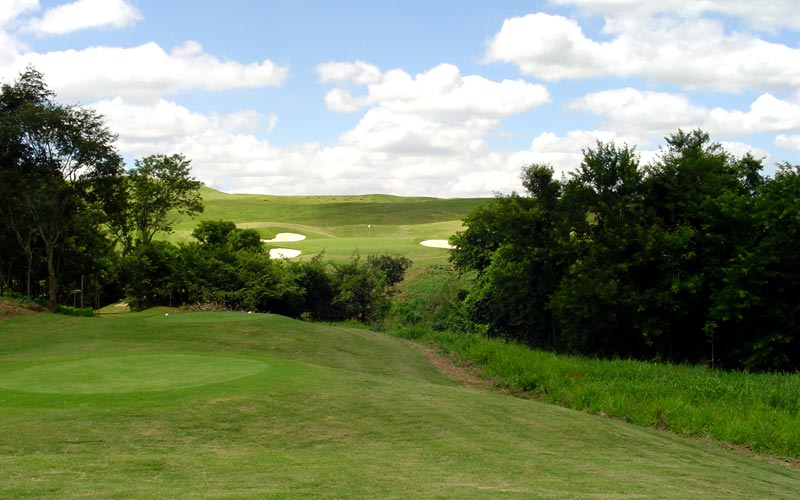
The 180 yard par three second at Boa Vista crosses a natural deep ravine that was created through years of tropical torrential rainfalls.
Please tell us about Las Estancia.
Las Estancias is our latest project that is finishing the grow-in phase. Nine holes should open in September and the other nine around the first of the year. It’s located about fifty minutes from Buenos Aires and is associated with a residential community. Around thirty percent of lot owners will make it there primary home and seventy percent will construct a second home for weekends. I have high expectations for the course and it is our first in the Buenos Aires area. The property has a river running through it and the hydraulic regulations don’t allow construction of homes within 100 meters of the river, so we routed six holes along the river. Most of the land surrounding Buenos Aries is flat and we were fortunate to encounter a little elevation change and also some good groves of native trees. The course should open with a more mature look instead of waiting ten years for the trees to grow. Par is seventy one and the course plays about seven thousand yards form the back tee. Good fundamental design states that you should start off with a medium length par four to allow the player to loosen up and to set a quick pace of play. The lay of the land told us something different though and the first hole is a long par four of 455 yards. We always try to get into the players head and this evolved indirectly into another tactic. Most players will walk off this hole talking to themselves and cussing us. The next time they play a round at Las Estancia maybe they will spend more time loosening up at the driving range. I think it’s going to be an overall good test of golf with a good variety of holes that will require constant thinking and provide a lot of alternative forms of attacking holes and also times requiring less aggression and if not paying the consequences. The course has more bunkering then we have ever done and at this point in time I can say I am pleased with the bunkering artistically but will have to play it before I can say if it has the right number of bunkers or if we went a little over board.
How did Kelly Blake Moran and you come to partner?
Kelly was hired at Von Hagge Design right out of school. His first project as lead architect was, The Cliffs at Possum Kingdom Lake. One of his first responsibilities was putting together the team for that project and he recommended me to Bob and I had an interview with Bob and was hired. We really started to form a good relationship during the construction of Buenos Aires Golf Course. He made a visit every month of two or three days during a three year period. We had a lot of freedom from Bob and a lot of support. We had a lot of deep conversations analyzing anything and everything during that three year period, sometimes agreeing and sometimes not. He wanted to move to the North East where his wife was originally from which meant leaving the security of Von Hagge Design. I saw the potential in the South American market for a more experienced design and construction team for the typical South American project which at the time meant, low to medium budget. Even though I think at the time I was more qualified then my local competition, and as much desire I had to be a golf course architect, I knew I was still a wannabe Architect. I was intelligent enough to realize I still had a lot to learn and Kelly could still teach me a lot, so we looked for a win-win situation. Kelly left Von Hagge and formed his own company in Eastern Pennsylvania but he knew he had a long road ahead trying to form a name on his own in the US market and even if he found a client tomorrow, it normally takes years to get the project off the ground and get the first paycheck. Not so in South America. So we made a verbal agreement to work together for a five year period and I think we both got our needs fulfilled.
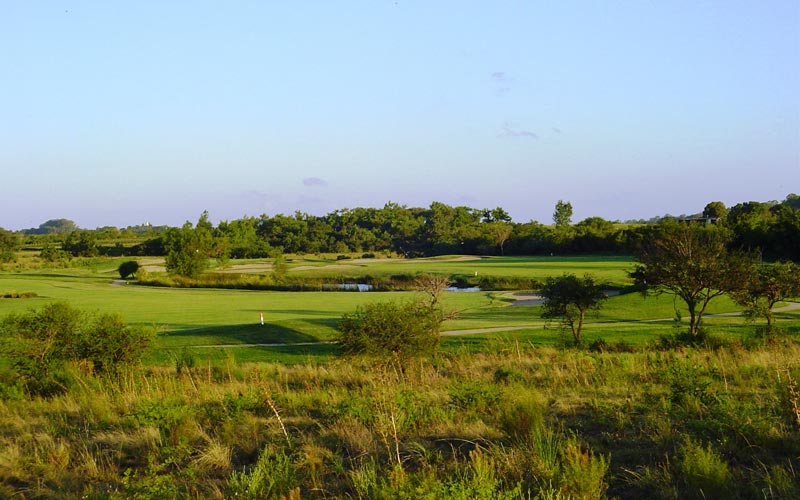
The residential sites of the Four Season’s Estates-Carmelo are situated fifty feet above the actual golf course. Working within the native swamps, the course feels surprisingly natural as it blends in with its surrounding.
How does your role as golf architect differ from those in other areas of the world?
We get involved with most of our clients form A-Z. Land planning, business planning, marketing strategies, clubhouse layouts, additional recreational amenities, construction planning and timing, training the superintendents etc. You end up trying to educate owners instead of having an interchange of ideas amongst various different professionals.
Why do you feel Mar del Plata is unique and what lessons can be learned studying Mar del Plata?
Mar del Plata is a great older traditional course that has stood the course of time and remains a fair and fun test of golf. The eighteen holes are laid out on approximately seventy acres including a driving range and six holes of par three for beginners. The course measures around 6200 0r 6300 yards from the back. The course sits about sixty feet above the ocean and is subject to constant changing winds and this remains the main defense of the course. A couple of the holes really set up a nice links style and the bunkers are deep and really have a natural look. Green surfaces are a native paspalum that allows for year around short heights of cut and as a result sometimes lighting speeds. I consulted at the club for several years trying to restore its original look and character while improving some of the maintenance practices. The greens and tees are irrigated and at one time they were considering upgrading the entire system to automatic wall to wall irrigation. I felt this would be a mistake. Fairways get hard and uneven and are constantly changing depending on the time of years and the rainfall in recent weeks and this is an important defense of the course. To make consistent perfect conditions throughout the course would in my opinion destroy the original character of this master piece.
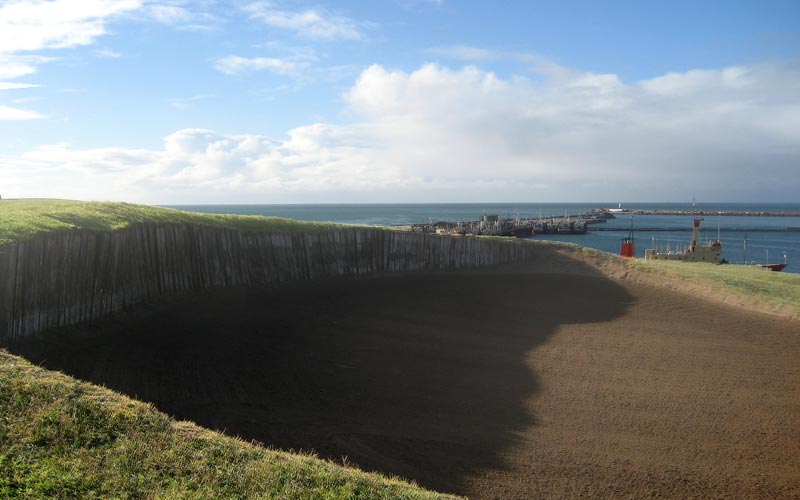
Note the planks lining the deep bunker above in the eighteenth fairway at Mar del Plata. Classic golf is truly alive and well in Argentina:
Describe how you became involved in the Four Seasons Carmelo.
The owner of the Hyatt in Buenos Aires was planning to construct a resort on the other side of the Rio del Plata in front of Buenos Aires. They were considering about five architects at the time and were asking for a pre-preliminary routing of the course and residential concepts. In my initial interview I explained that it was a waste of time for me to participate in such an exercise because I didn’t feel the owner was qualified to judge which was the best plan presented and why. If it was panel decision and on that panel was Fazio and Ed Stone then maybe it would be worth my time, having my concepts analyzed by experts. I had good feelings though with the group and they convinced me to participate in this initial exercise. We eventually were selected for two main reasons. We stayed on property three days discussing the various possibilities and alternatives and all the competition was in and out in a couple of hours. The competition routed the golf on the high part of the 400 ha including the far left of the property where there was a small sand dune area with a really nice pine forest definitely the gold mine of the property. We had two holes high and sixteen routed through the swamp or wetlands. The owner had four plans basically suggesting more or less the same theory and ours completely different. We explained that we routed golf low to leave the high for residential for making for a better overall IRR. We assured with imagination we could construct quality golf out of the wetlands and more importantly in an economical fashion. The owner expressed his concern that we weren’t really using the prime land on the left side of the property and we answered, reserved for phase two, after establishing a destination an additional eighteen holes may be desired including a second phase of residential. Although not an expert in land planning and golf routings, he liked our concern for his numbers and especially liked our capacity to think out of the box and we were hired.
How long did you live in Carmelo and how was it?
Chile had a boom in golf developments for about fifteen years but the market became saturated shortly after the turn of the century. Luckily we had our eggs in other baskets and to be specific in Brazil and in Argentina. Then nine eleven hit and the economies slowed in all areas down here. Argentina and Brazil went into huge economic crisis caused by major devaluation and four contracts came to a screeching halt all at the same time. In the meantime the owner of the project in Uruguay had contracted Four Seasons to manage the property and Four Seasons was recommending hiring a Director of Golf and he asked me if I could make some recommendations of possible candidates for their consideration. He also informed me he was looking for somebody to work with him on getting the real estate product around the golf up and running. After long discussions with my wife, she convinced me to enter into further discussions about my possible candidacy for the two positions. I made it clear that I was only interested if I could still keep devoting ten days a month to American Golf Course Design and we all came to an agreement for a two year contract. So, I worked as an employee of Four Seasons for two years and for the owner in relation to the Real Estate for three. During that time we developed and coordinated the construction of eighteen holes in Panama and nine in Brazil.
Carmelo was a great experience and I learned a lot, plus paradise to live in, it was like going to the Spa for three years, I miss the laid back life, even though I was wearing three hats and working thirty days a month.
What projects are you working on now, both in construction and on the drawing board?
We have recently finished Las Estancias de Pilar but the course flooded just prior to opening and one hole will need to be replanted, so that back nine probably won’t open until the end of the year. We also have a second nine in construction just outside of Sao Paulo, Brazil, which should be finished in about six months. We recently finished a design just outside of Buenos Aires Argentina, El Canton and that should start construction in the late spring of this year somewhere around October. We also just finished designing a thirty six hole golf course with residential component in the north of Argentina a city called Tucaman. If you saw the British this year, a young man was leading by two strokes with two holes to play, Andres Romero, anyways that is where he is from. That should go also to the construction phase early or late spring. In that same general area of El Canton, we have another one in the early design stages, San Sebastian Country Club. Also this week we started with a Master land plan to be followed by the golf design, just to the south of the city of Buenos Aires near the International airport, the project is called Villa Maria and this will be a co-design with a talented local architect Federico Mauer. We are also just signed a contract in the Caribbean just off the Venezuelan coast, an island called Isla Margarita. We have a proposal out in the south of Brazil and two more in the Buenos Aires vicinity. I have looked at potential projects in Jamaica and Ecuador for a repeat client that either one or both could become solid at any time but still are in the preliminary study phase.
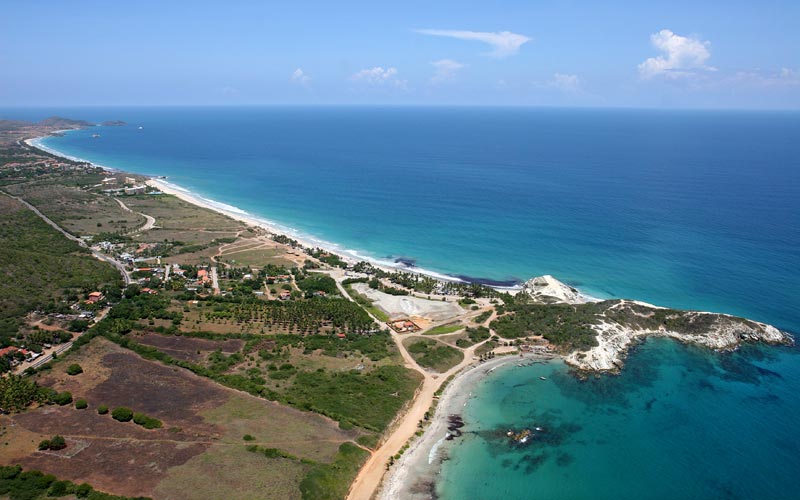
The potential of this future site is evident to all!
What is the future of golf in Latin America and what part do you see American Golf Design playing?
Golf will continue to grow in all areas but fueled by the need for the more secure residential community and the over all desire to escape the big cities for more of suburb lifestyle. We at American Golf Design are focusing on doing fewer projects and hopefully with repeat clients. I think we have established a foundation where our services will be solicited by the majority of serious clients. We want to be able to select the best projects including the best lands. We are also considering in the near future to study the possibility and putting some effort into raising a development fund from a few serious investors, to fund some prime projects. The IRR’s down here and in Central America are like no where else in the world. There are a lot of valid projects out there that require minimum start up investment but are not getting off the ground because normal lending practices from banks average around twenty five percent. That combined with the fact, that experienced teams are not assembled and are almost non existence. Whatever the case, we look forward to the future and no matter what we will embrace it with open arms and most importantly, have FUN!
The End








